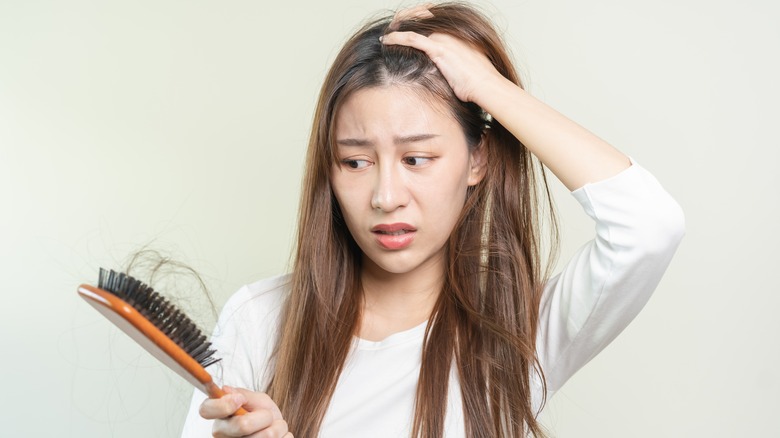What Are Postpartum Bangs And How Can You Handle Them?
You may think pregnancy is the worst part of having a new baby, especially when it comes to physical symptoms. But many women don't realize that their struggles may not only continue after birth, but new symptoms may appear. Some of the most common postpartum symptoms include fatigue, back pain, night sweats, and body aches (via What to Expect). Most of these symptoms occur and resolve within about six weeks after giving birth, but unfortunately, the body changes don't stop there.
According to Today's Parent, many women may not feel like themselves for quite a while after having a baby. Weight gain during pregnancy can often lead to spider veins and stretch marks that could, unfortunately, never go away (but they will fade). Your skin can also change and many women notice an onset of dark spots, dry patches, or even breakouts. But quite possibly the most concerning postpartum symptom for many women is hair loss. Many new moms will notice their hair thinning and after a few weeks or months, may start to notice they actually have something called postpartum bangs. Here's what they are and what you can do about them.
Postpartum bangs are a not-so-fun side effect of having a baby
You may have always wondered what you would look like with a set of bangs, but you likely didn't expect them to come in the form of short, hard-to-handle, pieces of hair at the front of your hairline. According to PureWow, this is what is referred to as postpartum bangs and can be a nuisance for many women hoping to get back to their former selves after having a baby. But before you start to panic when these baby bangs appear, remember they are actually a good thing. Dr. Jenny Liu, a board-certified dermatologist in Minnesota, told PureWow that postpartum bangs are actually a sign that your hair is beginning to grow back and they aren't permanent — most women will only experience these bangs for about nine months.
If you are dealing with postpartum hair loss and baby bangs, you aren't alone. As Today's Parent reported, losing about one-third of your hair about three months after birth is super common and normal. Celebrities like Ashley Graham have been vocal about their own struggle with postpartum bangs. The model and mom of three posted a photo of her bangs, saying "I mean at least it's growing." To get you through the months of regrowth, there are some things you can do to help.
How to manage and style postpartum bangs
If you are a new mom, you are already dealing with a lot. But in order to be the best mother to your new baby, you need to also feel your best. The American Academy of Dermatology Association suggests switching your hair care products to ones that promote volume and fullness. They advise sticking to products that have proteins in them to help the hair appear fuller and to avoid anything that has conditioning in it as the heavy product can weigh your hair down and contribute to that dull look you are trying to avoid. In addition to products, you may also want to try a new style with your hair or a haircut to not only make it look better, but also to keep it healthy so it can continue to grow.
Phillip B. — hairstylist and founder of Philip B. — told PureWow that he recommends hairspray to help tame your postpartum bangs, using a toothbrush to carefully comb them back. He also tells new moms to put away their hot tools for the time being, as their new thinner hair is more prone to damage. Instead, consider letting your natural locks shine through or using the cool setting if you can't go without a blow dry. Hair accessories like headbands and headscarves are also great options for lazier days and stick to lower buns, ponytails, and short hairstyles to keep the hair from pulling at the scalp.

